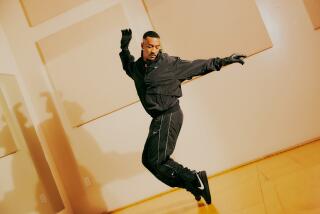Cholly Atkins, 89; Tap Dancer, Motown Stars’ Choreographer
- Share via
Cholly Atkins, who joined Charles “Honi” Coles in probably the most distinctively elegant tap-dance duo of the late 1940s through the mid-1960s, but later achieved his greatest fame as a choreographer for Motown’s leading singing groups, has died. He was 89.
The consummate dancer, who developed what he called “vocal choreography” to enhance the performances of non-dancers, died Saturday in Las Vegas of pancreatic cancer.
“Cholly helped make the Supremes a class act,” Mary Wilson told the Washington Post in 1994. “He taught us that grace.” Specifically, Atkins developed a way of reinforcing song lyrics with a stylish combination of steps and gestures that soon became as well known as the songs themselves. “He got the Supremes to Stop! (right hand up, strong) in the Name of Love!” Florangela Davila wrote in the Seattle Times in 1996. “He made those fingers naughty and those hips sassy.”
“He was so underrated and overlooked for the contributions that he made to our industry,” Motown star Gladys Knight commented earlier this week. “There is not one African American artist that he did not touch in some way.”
He was born Charles Atkinson on Sept. 30, 1913, in Pratt City, Ala., and always said he learned to dance from his mother. She “used to go to the dance halls and come back and teach me how to dance,” he told the New York Amsterdam News in 2001. “She used to have me dance for her friends.”
After winning a Charleston dance contest in Buffalo, N.Y., in 1923, he became a singing waiter in upstate New York and then teamed up with William Porter in a tap act called the Rhythm Pals. The team dissolved in the late 1930s, and Atkins took a number of different jobs, working in “The Hot Mikado” at the 1939 World’s Fair and then with dancer Dottie Saulters in gigs with a number of major bands of the era.
In 1946, after a stint in the Army, he and Coles got together for a memorable partnership that included stints on Broadway in “Gentlemen Prefer Blondes,” performances in Las Vegas, guest shots in forgettable movies, and showcases with major jazz and swing bands, including those led by Louis Armstrong, Charlie Barnet, Count Basie, Cab Calloway and Lionel Hampton.
In his book “Black Dance,” British dance critic Edward Thorpe describes Coles and Atkins as “the ultimate example of what other protagonists of American vernacular dance call ‘a class act,’ and there can be no higher praise than that.”
But as the popularity of tap waned, Atkins began to take jobs staging the performances of popular vocal groups, beginning with the Cadillacs. Sammy Strain of the O’Jays told the Washington Post that Atkins’ steps were “so simple, little pivots and stuff, but so hard I’d have nightmares over them.” In the process, a new style of pop performance was born.
Atkins joined the staff of Motown Records in 1965 and remained through 1971 -- a period that found him making indelible contributions to the careers of the Supremes, the Temptations, Gladys Knight and the Pips, Smokey Robinson and the Miracles, Aretha Franklin, Marvin Gaye and others.
“Motown hired me as an artist developer,” Atkins told the Amsterdam News. “I wanted to make a harmonious marriage between the singing and the dancing -- the visual.”
His 1944 marriage to Dorothy Lee ended in divorce in 1962. The following year, he married Maye Harrison Anderson, and in 1975, the couple moved to Las Vegas. There Atkins continued to stage nightclub acts. But over the years, he left for occasional projects, such as the 1988 Broadway tap-revival musical “Black and Blue,” for which he won a Tony Award.
He also accepted a 1993 National Endowment for the Arts three-year fellowship to tour colleges and universities teaching vocal choreography as a full-fledged dance idiom. He taught dance in Las Vegas until February, when he was diagnosed with cancer.
“He loved his work,” said his wife, Maye. “That was his life.”
More to Read
The biggest entertainment stories
Get our big stories about Hollywood, film, television, music, arts, culture and more right in your inbox as soon as they publish.
You may occasionally receive promotional content from the Los Angeles Times.










